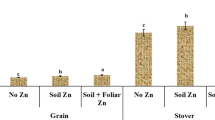Abstract
Zinc (Zn) deficiency in humans is a widespread problem across the globe. Since, vegetables are the important constituent of daily diet, it is very useful to enrich leafy vegetables with Zn in alleviating Zn deficiency in humans. Greenhouse pot experiment was conducted to evaluate the effects of applied Zn and organics on shoot Zn content and dry biomass yield of Chenopodium album grown in acid and alkaline soils. Zinc content increased significantly with increase in Zn level. Zinc content gets reduced to a great extent due to application of farmyard manure (FYM) and sludge in acid soil. As far as dry biomass yield is concerned, the crop responded positively to applied level of Zn @ 5 mg kg−1 in alkaline soil, while such response was conspicuously absent in acid soil. In case of alkaline soil, significant reduction in dry biomass yield occurred only at 100 mg Zn kg−1, whereas such reduction was recorded in acid soil even at 50 mg Zn kg−1. With reference to recommended dietary allowances of Zn for humans, substantial enrichment of Chenopodium in terms of Zn content is possible due to application of Zn from external sources. Taking health risk into consideration, applied rate of Zn may go up to 100 mg kg−1 for alkaline soil as against 50 mg kg−1 for acid soil in enriching Chenopodium with Zn.
Similar content being viewed by others
References
Singh MV (2001) Evaluation of micronutrient status in different agro-ecological zones of India. Fert News 46:25–42
Hotz C, Brown KH (2004) Assessment of the risk of zinc deficiency in populations and options for its control. Food Nutr Bull 25:194–204
Gibson RS (2006) Zinc: the missing link in combating micronutrient malnutrition in developing countries. Proc Nutr Soc 65:51–60
Cakmak I (2008) Enrichment of cereal grains with zinc: agronomic or genetic biofortification? Plant Soil 302:1–17
Rattan RK, Datta SP, Katyal JC (2008) Micronutrient management: research achievements and future challenges. Indian J Fert 4:103–106
Katyal JC, Rattan RK, Datta SP (2004) Management of zinc and boron for sustainable food production in India. Fert News 49:83–90
Mirshekali H, Hadi H, Amirnia R, Khodaverdiloo H (2012) Effect of zinc toxicity on plant productivity, chlorophyll and Zn contents of sorghum (Sorghum bicolor) and common lambsquarter (Chenopodium album). Int J Agric 2:247–254
Sharma KD, Bindal G, Rathour R, Rana JC (2012) β-Carotene and mineral content of different Cenopodium species and the effect of cooking on micronutrient retention. Int J Food Sci Nutr 63:290–295
Glowacka A (2012) Content and uptake of microelements (Cu, Zn, Mn, Fe) by maize (Zea mays L.) and accompanying weeds. Acta Agrobot 65:179–188
Gupta UC, Gupta SC (1998) Trace element toxicity relationships to crop production and livestock and human health: implications for management. Commun Soil Sci Plant Anal 29:1491–1522
Jackson ML (1973) Soil chemical analysis. Prentice Hall of India Private Limited, New Delhi
Lindsay WL, Norvell WA (1978) Development of a DTPA soil test for zinc, iron, manganese and copper. Soil Sci Soc Am J 42:421–428
Snyder JD, Trofymow JA (1984) A rapid accurate wet oxidation diffusion procedure for determining organic and inorganic carbon in pot and soil samples. Commun Soil Sci Plant Anal 15:587–597
IRIS (2011) Integrated risk information system-database. United States Environmental Protection Agency, Washington
Snedecor GW, Cochran WG (1967) Statistical methods, 7th edn. The Lowa State University Press, USA
Chaudhary M, Narwal NP (2005) Effect of long-term application of farmyard manure on soil micronutrient status. Arch Agron Soil Sci 51:351–359
Lal P (1990) Effects of sewage effluents and sludge on soil enzyme activity and heavy metal accumulation in soil and plants. Dissertation, Indian Agricultural Research Institute, New Delhi
Talatam S, Parida B (2009) Crop growth as affected by zinc and organic matter in cadmium rich polluted soils. In: Proceedings of the international plant nutrition colloquium XVI, Department of Plant Sciences, UC Davis
Georgieva V, Tasev C, Senalevitch G (1997) Growth, yield, lead, Zn and Cd content of radish, pea and pepper plants as influenced by level of single and multiple contamination of soil III Cd. Bulg J Plant Physiol 23:12–23
Lindsay WL (1979) Chemical equilibria in soils. Willey Inter Sciences, New York
Narwal RP, Antil RS, Gupta AP (1992) Soil pollution through industrial effluents and waste management. J Soil Contam 1:265–272
Brown SL, Henry CL, Chaney RL, Compton H, DeVolder PS (2003) Using municipal bio-solids in combination with other residuals to restore metal-contaminated mining areas. Plant Soil 249:203–215
Vacha R, Podlesakova E, Nemecek J, Polacek O (2002) Immobilization of As, Cd, Pb and Zn in agricultural soils by the use of organic and inorganic additives. Rostl Vyr 48:335–342
Grzetic I, Rabia H, Ghariani A (2008) Potential health risk assessment for soil heavy metal contamination in the central zone of Belgrade (Serbia). J Serb Chem Soc 73:923–934
Alam MGM, Snow ET, Tanaka A (2003) Arsenic and heavy metal contamination of vegetables grown in Samta village, Bangladesh. Sci Total Environ 308:83–96
Acknowledgments
Authors would like to place on record their sincere thanks to Indian Council of Agricultural Research (ICAR), New Delhi, India for providing the necessary funding and laboratory facilities required for conducting the study.
Author information
Authors and Affiliations
Corresponding author
Rights and permissions
About this article
Cite this article
Ray, P., Singhal, S.K., Datta, S.P. et al. Effect of Zinc Sulphate and Organics on Zn Content and Yield of Chenopodium Grown in Different Soils. Proc. Natl. Acad. Sci., India, Sect. B Biol. Sci. 87, 697–704 (2017). https://doi.org/10.1007/s40011-015-0649-z
Received:
Revised:
Accepted:
Published:
Issue Date:
DOI: https://doi.org/10.1007/s40011-015-0649-z




